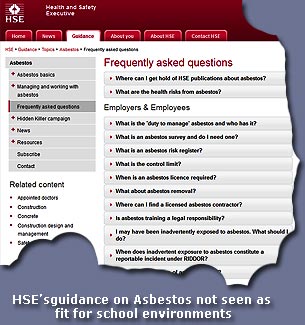HSE Guidance And Recommendations For Asbestos In Schools Controversy Continues
For many years there has been controversy over the HSE guidance on asbestos, particularly of its threshold level after which action must be taken, not only in the wider working environment, but also when found within schools.
For years it was argued that the HSE threshold was dangerously high and was contrary to expert medical and legal opinion.
One pressure group concerned with Asbestos, its existence in school buildings and the risk to children and staff of it not being removed argued successfully for HSE’s flawed guidance to be withdrawn.
 As a result of representation to the HSE and government departments, finally in December 2011 LAC 5/19 was withdrawn and later in February this year, the withdrawal of OC 265/48 took place. The HSE guidance that refers to the Action Level as a threshold for an exposure that would “usually have been insufficient to cause a significant long term risk to health” has been withdrawn.
As a result of representation to the HSE and government departments, finally in December 2011 LAC 5/19 was withdrawn and later in February this year, the withdrawal of OC 265/48 took place. The HSE guidance that refers to the Action Level as a threshold for an exposure that would “usually have been insufficient to cause a significant long term risk to health” has been withdrawn.
The main group involved in the HSE's action is The Asbestos in Schools Group (AISG) who have produced a paper giving the case for withdrawing of the HSE guidance. It also argues that workplace control levels should not be applied to children in schools. The case for an environmental control level for schools is in their report, Mesothelioma, Benchmark Levels of Asbestos Exposure.
The new HSE guidance gives advice on what to do following an inadvertent exposure to asbestos and also when to make a RIDDOR report. The new guidance no longer gives an artificially high threshold and can be found here
However, the issue of Asbestos in schools is not adequately covered by the HSE guidance and so the AISG have produced argument and evidence in their report which gives the following recommendations, some of which have already been carried out; with regard to Asbestos in schools:
* Workplace control levels should not be applied to the occupants of schools. In particular
they should not be applied to children.
* DfE should no longer refer schools or local authorities to the HSE guidance OC 265/48 or
LAC5/19, until they are amended.
* Local Authorities should no longer refer schools to the HSE guidance until they are amended.
* Both OC265/48 version 3 and the associated LAC 5/19 should be withdrawn from the HSE
web-site and publications list and amended.
* The present table of work activities and times in the guidance should be deleted.
* Any reference to the Action level or 48f/ml being normally insufficient to pose a significant
long-term risk should be deleted from the guidance.
* The advice that an incident should only be reported to RIDDOR if the level of exposure
exceeds the Action Level should be withdrawn.
* Levels above the Control limit should always be reported by schools and local authorities to
HSE as dangerous occurrences under RIDDOR legislation.
* If there is an asbestos incident in a school and, as is usually the case, the level of exposure is
unknown, the incident should be reported under RIDDOR.
* The Department for Health Committee on Carcinogenicity (COC) has been tasked to assess
the relative vulnerability of children to asbestos. As part of that they should be asked to
consider the asbestos risks to children from the Action Level, the Control Limits and the
Clearance Level.
*The COC should be asked to recommend an environmental limit for asbestos fibre levels in
schools.
The full reports entitled 'Informing Following An Asbestos Incident In A School' and 'Mesothelioma, Benchmark Levels of Asbestos Exposure' can be downloaded from the E-Library Database by selecting category 'Asbestos (in Schools)'.
Source: Asbestos In Schools Group / HSE


